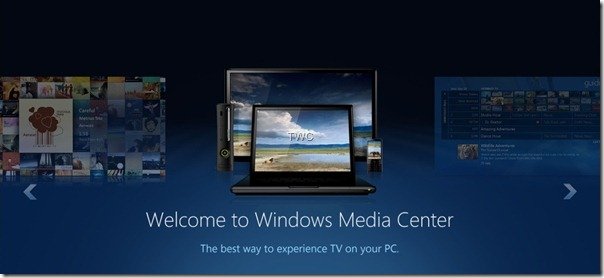Yesterday as Windows 8 blogged about Windows Media Center in Windows 8, lots of people had many related questions on DVD playback support , media player and Media center in Windows 8. People had the query that – Why will Windows 8 not have DVD Playback Support in Windows Media Player ?

Bernardo Caldas of the Windows Business Group and Linda Averett, Lead, Program Management for the Developer Experience team posted :
….we’ve decided to make Windows Media Center available to Windows 8 customers via the Add Features to Windows 8 control panel (formerly known as Windows Anytime Upgrade). This ensures that customers who are interested in Media Center have a convenient way to get it. Windows Media Player will continue to be available in all editions, but without DVD playback support. For optical discs playback on new Windows 8 devices, we are going to rely on the many quality solutions on the market, which provide great experiences for both DVD and Blu-ray…
From the above quote it’s clear that Windows Media Center will be made available in two ways: Media Center Pack and The Windows 8 Pro Pack. Both will give you the Media Center and will include support for :
- DVD playback (in Media Center, not in Media Player)
- Broadcast TV recording and playback (DBV-T/S, ISDB-S/T, DMBH, and ATSC)
- VOB file playback.
Having said that, it is important to highlight certain facts such as, if Windows 7 user upgrades to Windows 8, will he get the DVD playback support with the codecs which were originally present in Windows 7? Replying to number of good and bad comments the blog received during this brief period, Microsoft decided to post a follow up of that post and provide answers to FAQ’s.
Let us in brief discuss some of the main points of the FAQs posted on the Windows 8 Blog:
What are codecs? What codecs are needed to play DVDs in Windows?
A codec is software that is used to compress or decompress a digital media file, such as a song or video. Playing DVDs generally require MPEG-2 video compression and Dolby Digital (AC-3) audio.
How was the DVD related decoder licensing done in versions earlier than Windows 8?
In some Editions like Windows Vista Starter, Home Basic, Business and Enterprise, DVD playback was not included. OEMs had the option to include Dolby Digital codec to support DVD playback at a nominal price increase. There were also special editions such as Media Center Edition for Windows XP and Vista.
In Windows 7, codecs were present in most editions except Home Basic and Starter. So, whether a PC had an optical drive or not, DVD playback royalty was paid in Windows 7. So I think, taking into consideration this fact Microsoft has decided not to include support for DVD Playback
By whom and to whom will royalties for the DVD playback decoder on PCS be paid?
Those entities who wish to include the codecs in their product should pay royalties to Intellectual Property owners. So, for a new PC with Windows pre-installed, it has to be OEMs. On the other hand, Microsoft will pay directly to Dolby for Windows 7 featuring built-in Dolby Technology.
Windows 8 will include technologies licensed by MPEG-LA and Dolby and royalty for this will be paid by OEMs. This will be related only to online media consumption and not to Optical media. These costs though lower are significant for Optical media playback and Windows 8 apps too will utilise these technologies at no additional costs.
Does it really cost much for the PC ecosystem to play DVDs?
The Codecs required to play DVDs are MPEG-2 video compression and Dolby Digital (AC-3) for audio. And majority of commercial DVDs are encoded in these formats. The playback devices which decode them need to be licensed. MPEG-2 decoder costs $2.00 per unit while Dolby license cost varies depending on various factors. If you would like to add Blu Ray support, you will have to pay more. So if you were to add up all these costs to Windows PC ecosystem you would be surprised to know that comes to hundreds and millions of dollars per year
Will pre-installed Windows 8 support DVDs out of the box?
The decision will solely depend on OEM as to which software should be included. If a new device has an optical drive then it makes sense to include the necessary software for a seamless experience. If someone makes the decision of getting an add-on Optical drive then there is a high probability that it too will include the DVD playback software. This way you get third-party DVD playback software, licensed properly. Thus, ecosystem frees itself from the chances of paying for the software and for royalties on devices like tablets, small form factor desktops and laptops without optical drives.
What happens to codecs usage rights if someone upgrades Windows 7 with Optical drive to Windows 8?
If it is present it means Windows 7 user is using DVD playback third-party software. Windows 8 upgrade assistant will determine if it is compatible or not and if it is you will be granted with the option to keep the software also in Windows 8. If not, you will be forced to get third-party software compatible with Windows 8. Another option is to get Windows 8 Media Center Pack or the Windows 8 Pro Pack to play DVDs.
If you are planning to upgrade then please note that the usage rights to the codecs purchased with Windows 7 DO NOT CARRY FORWARD to Windows 8 or to a new version of Windows. These terms are not decided by Microsoft but by Technology licensors.
Why all Windows 8 devices won’t support DVD playback capability? What about its support for Media Center and Windows Media Player? What’s Windows 8 Pro Pack?
Microsoft decided that DVD and broadcast TV functionalities will not be made available to all Windows 8 editions. The decision got its approval after studying the media consumption patterns among users. It was observed that many new and upcoming devices such as tablets were light in weight, thin and had no optical drives. Moreover, consumers had started to turn more towards online media consumption. So it was completely unnecessary to include the license in all Windows version. Instead, those capabilities will be available to customers who wish to add this feature via Windows 8 Pro Pack. Windows 8 Pro Pack can be regarded as an updated version of Windows 8. Windows Media Center is only available on Windows 8 Pro. If you already have Windows 8 Pro and want to add Media Center, you just need to acquire the additional Media Center Pack. The Windows 8 Pro edition that includes Media Center will have the name Windows 8 Pro with Media Center. And this will not be a new Edition.
The version of Media Center included in Windows 8 is the one currently used in Windows 8 Consumer Preview.
The CableCard and other devices will continue to work with Media Center in Windows 8 as there’s no change in hardware support. It should be mentioned here that this Media Center is more solid and consistent in comparison to the one observed in Windows 7.
Please note that DVD playback in Windows Media Player won’t be enabled even after installing Media Center. Why? Just to avoid overlapping feature between the two and avoid complexity with the previously installed component. DVD playback will be enabled only in Media Center. To enable the DVD Playback support in Windows Media Player you will have no other option but to rely on third-party applications.
So you can see Microsoft has tried to clear some of the confusion regarding DVD playback support in Windows Media player and Media Center however, so many questions still remains unanswered.
“Gadget Deals Unlocked: Save Big on the Latest Tech!”





